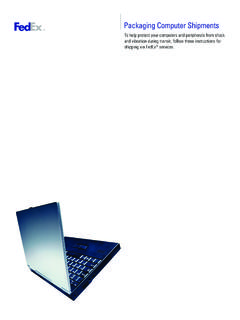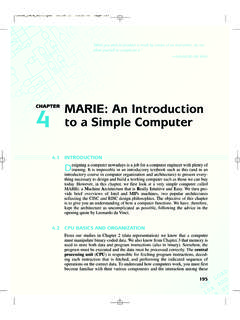Transcription of MARIE: An Introduction to a Simple Computer
1 10/18/10 12:03 PM Page 195. When you wish to produce a result by means of an instrument, do not allow yourself to complicate it.. Leonardo da Vinci CHAPTER. MARIE: An Introduction 4 to a Simple Computer Introduction . esigning a Computer nowadays is a job for a Computer engineer with plenty of Dtraining. It is impossible in an introductory textbook such as this (and in an introductory course in Computer organization and architecture) to present every- thing necessary to design and build a working Computer such as those we can buy today. However, in this chapter, we first look at a very Simple Computer called MARIE: a Machine Architecture that is Really Intuitive and Easy. We then pro- vide brief overviews of Intel and MIPs machines, two popular architectures reflecting the CISC and RISC design philosophies. The objective of this chapter is to give you an understanding of how a Computer functions. We have, therefore, kept the architecture as uncomplicated as possible, following the advice in the opening quote by Leonardo da Vinci.
2 CPU BASICS AND ORGANIZATION. From our studies in Chapter 2 (data representation) we know that a Computer must manipulate binary-coded data. We also know from Chapter 3 that memory is used to store both data and program instructions (also in binary). Somehow, the program must be executed and the data must be processed correctly. The central processing unit (CPU) is responsible for fetching program instructions, decod- ing each instruction that is fetched, and performing the indicated sequence of operations on the correct data. To understand how computers work, you must first become familiar with their various components and the interaction among these 195. 10/18/10 12:03 PM Page 196. 196 Chapter 4 / MARIE: An Introduction to a Simple Computer components. To introduce the Simple architecture in the next section, we first examine, in general, the microarchitecture that exists at the control level of mod- ern computers. All computers have a CPU that can be divided into two pieces.
3 The first is the datapath, which is a network of storage units (registers) and arithmetic and logic units (for performing various operations on data) connected by buses (capable of moving data from place to place) where the timing is controlled by clocks. The second CPU component is the control unit, a module responsible for sequencing operations and making sure the correct data are where they need to be at the cor- rect time. Together, these components perform the tasks of the CPU: fetching instructions, decoding them, and finally performing the indicated sequence of operations. The performance of a machine is directly affected by the design of the datapath and the control unit. Therefore, we cover these components of the CPU. in detail in the following sections. The Registers Registers are used in Computer systems as places to store a wide variety of data, such as addresses, program counters, or data necessary for program execution. Put simply, a register is a hardware device that stores binary data.
4 Registers are located on the processor so information can be accessed very quickly. We saw in Chapter 3 that D flip-flops can be used to implement registers. One D flip-flop is equivalent to a 1-bit register, so a collection of D flip-flops is necessary to store multi-bit values. For example, to build a 16-bit register, we need to connect 16 D. flip-flops together. We saw in our binary counter figure from Chapter 3 that these collections of flip-flops must be clocked to work in unison. At each pulse of the clock, input enters the register and cannot be changed (and thus is stored) until the clock pulses again. Data processing on a Computer is usually done on fixed-size binary words stored in registers. Therefore, most computers have registers of a certain size. Common sizes include 16, 32, and 64 bits. The number of registers in a machine varies from architecture to architecture, but is typically a power of 2, with 16 and 32 being most common.
5 Registers contain data, addresses, or control information. Some registers are specified as special purpose and may contain only data, only addresses, or only control information. Other registers are more generic and may hold data, addresses, and control information at various times. Information is written to registers, read from registers, and transferred from register to register. Registers are not addressed in the same way memory is addressed (recall that each memory word has a unique binary address beginning with location 0). Registers are addressed and manipulated by the control unit itself. In modern Computer systems, there are many types of specialized registers: registers to store information, registers to shift values, registers to compare val- ues, and registers that count. There are scratchpad registers that store temporary values, index registers to control program looping, stack pointer registers to man- 10/18/10 12:03 PM Page 197.
6 / The Bus 197. age stacks of information for processes, status (or flag) registers to hold the status or mode of operation (such as overflow, carry, or zero conditions), and general purpose registers that are the registers available to the programmer. Most comput- ers have register sets, and each set is used in a specific way. For example, the Pentium architecture has a data register set and an address register set. Certain architectures have very large sets of registers that can be used in quite novel ways to speed up execution of instructions. (We discuss this topic when we cover advanced architectures in Chapter 9.). The ALU. The arithmetic logic unit (ALU) carries out the logic operations (such as com- parisons) and arithmetic operations (such as add or multiply) required during the program execution. You saw an example of a Simple ALU in Chapter 3. Generally an ALU has two data inputs and one data output. Operations performed in the ALU often affect bits in the status register (bits are set to indicate actions such as whether an overflow has occurred).
7 The ALU knows which operations to per- form because it is controlled by signals from the control unit. The Control Unit The control unit is the policeman or traffic manager of the CPU. It monitors the execution of all instructions and the transfer of all information. The control unit extracts instructions from memory, decodes these instructions, making sure data are in the right place at the right time, tells the ALU which registers to use, services interrupts, and turns on the correct circuitry in the ALU for the execution of the desired operation. The control unit uses a program counter register to find the next instruction for execution and a status register to keep track of overflows, carries, borrows, and the like. Section covers the control unit in more detail. THE BUS. The CPU communicates with the other components via a bus. A bus is a set of wires that acts as a shared but common datapath to connect multiple subsystems within the system.
8 It consists of multiple lines, allowing the parallel movement of bits. Buses are low cost but very versatile, and they make it easy to connect new devices to each other and to the system. At any one time, only one device (be it a register, the ALU, memory, or some other component) may use the bus. However, this sharing often results in a communications bottleneck. The speed of the bus is affected by its length as well as by the number of devices sharing it. Quite often, devices are divided into master and slave categories; a master device is one that initiates actions and a slave is one that responds to requests by a master. A bus can be point-to-point, connecting two specific components (as seen in Figure ) or it can be a common pathway that connects a number of devices, 10/18/10 12:03 PM Page 198. 198 Chapter 4 / MARIE: An Introduction to a Simple Computer Serial Modem Port (a). Control ALU Unit Printer (b). Computer 1. Computer 2. File Server Disk CPU Disk Memory Controller Monitor Disk Controller FIGURE a) Point-to-Point Buses b) Multipoint Buses 10/18/10 12:03 PM Page 199.
9 / The Bus 199. requiring these devices to share the bus (referred to as a multipoint bus and shown in Figure ). Because of this sharing, the bus protocol (set of usage rules) is very impor- tant. Figure shows a typical bus consisting of data lines, address lines, control lines, and power lines. Often the lines of a bus dedicated to moving data are called the data bus. These data lines contain the actual information that must be moved from one location to another. Control lines indicate which device has per- mission to use the bus and for what purpose (reading or writing from memory or from an input/output [I/O] device, for example). Control lines also transfer acknowledgments for bus requests, interrupts, and clock synchronization signals. Address lines indicate the location ( , in memory) that the data should be either read from or written to. The power lines provide the electrical power nec- essary. Typical bus transactions include sending an address (for a read or write), transferring data from memory to a register (a memory read), and transferring data to the memory from a register (a memory write).
10 In addition, buses are used for I/O reads and writes from peripheral devices. Each type of transfer occurs within a bus cycle, the time between two ticks of the bus clock. Because of the different types of information buses transport and the various devices that use the buses, buses themselves have been divided into different types. Processor-memory buses are short, high-speed buses that are closely matched to the memory system on the machine to maximize the bandwidth (transfer of data) and are usually design specific. I/O buses are typically longer than processor-memory buses and allow for many types of devices with varying bandwidths. These buses are compatible with many different architectures. A. backplane bus (Figure ) is actually built into the chassis of the machine and Power CPU. Address Lines Data Lines Main Control Lines Memory I/O I/O. Device Device I/O Subsystem FIGURE The Components of a Typical Bus 10/18/10 12:03 PM Page 200.


















